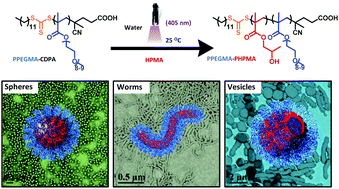Photochemistry is an incredibly useful field of chemistry which allows for temporal control of reactions through the presence of light. Specifically when applied in polymer chemistry, light can be used to achieve conformational changes, modify polymer chains and to polymerise monomers. This month, focusing on photopolymerisation, we take a look at three papers and a communication, featured in Polymer Chemistry, which utilise light to polymerise various monomers via different techniques, including: reversible-deactivation radical polymerisations and curing of coatings and bulk materials. The vast scope of these articles highlights the applicability of photochemistry as a versatile approach to polymer synthesis.
1. Room temperature synthesis of poly(poly(ethylene glycol) methyl ether methacrylate)-based diblock copolymer nano-objects via Photoinitiated Polymerization-Induced Self-Assembly (Photo-PISA), Jianbo Tan, Yuhao Bai, Xuechao Zhang, Li Zhang, Polym. Chem., 2016, 7, 2372-2380.
The authors describe the chain extension of a hydrophilic macromolecular chain transfer agent (macroCTA) with hydroxypropyl methacrylate, through a light-mediated PISA approach. A visible light LED (405 nm) was used and the aqueous photo-PISA reactions achieved high conversion within 30 min irradiation time. Nano-objects with various morphologies were realised and investigated for their thermoresponsive properties.
2. Extremely deep photopolymerization using upconversion particles as internal lamps, Ren Liu, Hao Chen, Zhiquan Li, Feng Shi, Xiaoya Liu, Polym. Chem., 2016, 7, 2457-2463
Photopolymerisation was reported through thick samples by using upconversion nanoparticle (UCNP) assisted photochemistry. Through near-infrared laser excitation, the UCNPs produce visible light, which is adsorbed by a photo-initiator and causes curing of the material. Using this technique 60% conversion of double bonds has been achieved through a sample depth of 13.7 cm, and shows promise for ultra-high density data storage and preparation of functional composites.
3. Towards mussel-like on-demand coatings: light-triggered polymerization of dopamine through a photoinduced pH jump, David Perrot, Céline Croutxé-Barghorn, Xavier Allonas, Polym. Chem., 2016, 7, 2635-2638.
In this communication, the authors present a light triggered polymerisation of dopamine to give highly adhesive coatings. The irradiation of quaternary ammonium salts of phenylglyoxylic acid acted as photobase generators. This release of a strong base in water causes the polymerisation of dopamine through a self-oxidative polymerisation process. The presented methodology shows potential as a one-pot on-demand approach for the polymerisation of dopamine on various substrates.
4. Efficient multiblock star polymer synthesis from photo-induced copper-mediated polymerization with up to 21 arms, B. Wenn, A. C. Martens, Y.-M. Chuang, J. Gruber, T. Junkers, Polym. Chem., 2016, 7, 2720-2727
Here, utilising different multi-functional initiators, various star copolymers have been prepared via a photo-induced copper mediated polymerisation technique. Using a UV-microflow reactor, various multiarm-multiblock star-copolymers were prepared with varying acrylic block copolymer compositions, with low dispersities. Through post-polymerisation hydrolysis amphiphilic materials were prepared which showed pH-responsiveness and complex self-assembly in solution.
Dr. Fiona Hatton is a Web Writer for Polymer Chemistry. She is currently a postdoctoral researcher in the Armes group at the University of Sheffield, UK.











